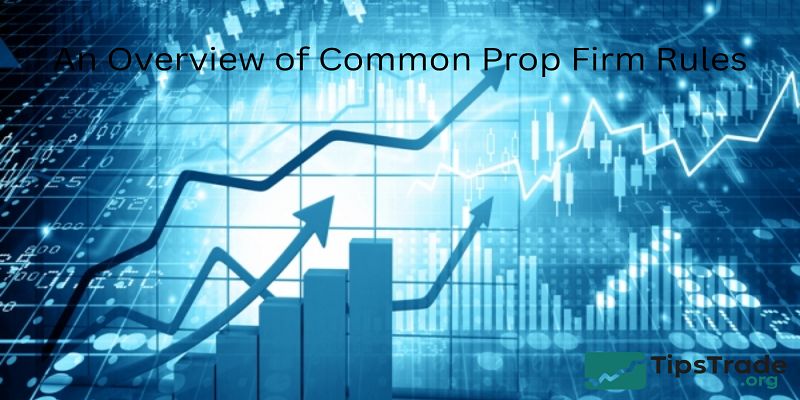Prop Firm rules are essential guidelines set by proprietary trading firms to ensure disciplined, consistent, and risk-controlled trading. These rules commonly include limits on maximum loss per trade, daily and overall drawdown limits, and restrictions on the types of instruments and leverage that traders can use. Prop firms design these rules to protect their capital while creating a structured environment that fosters sustainable profitability for traders. Adhering to these rules is crucial for traders to maintain their funded accounts and continue scaling their trading careers.
An Overview of Common Prop Firm Rules

Drawdown Rules (Maximum Loss Limits)
- The most important Prop Firm rule is the maximum drawdown.
- This sets a limit on how much a trader can lose before failing an evaluation or losing a funded account.
- For example, if a firm provides $100,000 and sets a 10% max drawdown, the lowest equity a trader can reach is $90,000. Violating this rule results in immediate disqualification.
- These limits are not meant to discourage traders, but to enforce discipline.
- Experienced traders know that managing drawdown is central to professional risk control.
- Research by Finance Magnates (2023) found that more than 70% of failed evaluations were due to hitting drawdown limits rather than missing profit targets.
Traders should adapt by risking only 1–2% per trade and by tracking equity balance daily. Simple tools like trade journals or equity trackers help keep performance aligned with firm expectations.
Daily Loss Limits
- Another strict Prop Firm rule is the daily loss limit, often around 4–5% of the account. This prevents traders from blowing up accounts in a single day of bad decisions.
- For instance, if a trader on a $50,000 account has a $2,500 daily loss limit, exceeding it—even by $1—means instant failure.
- From experience, many traders fail because of emotional overtrading after a losing streak.
- A 2022 Trader Psychology Journal survey revealed that traders who set personal “stop trading” rules reduced failure rates by 32%.
- The key is to treat daily loss rules as a protective boundary, not a limitation.
To comply, traders can:
- Set a maximum of 2–3 trades per day.
- Stop trading after hitting a predetermined loss.
- Use alerts on trading platforms to warn when nearing the daily limit.
Minimum Trading Days
- Many firms require traders to trade for a minimum number of days—often 5 to 10 days—before completing a challenge.
- This prevents “one-trade wonders” where traders hit profit targets in a single lucky trade.
- For example, FTMO requires at least 10 trading days in the evaluation phase.
- This forces traders to demonstrate consistency over time.
- While some see this as restrictive, it actually reflects real-world trading, where steady profits matter more than random wins.
- Traders can adapt by scaling position sizes and spacing trades.
- Even if a target is achieved early, they should continue to trade lightly to fulfill the minimum-day rule.
- This also builds psychological discipline, teaching traders that consistency outweighs fast profits.
Maximum Position Size or Trade Volume
- Some firms enforce rules on maximum lot sizes or total open positions.
- This ensures traders don’t take excessive risks by opening oversized trades.
- For instance, a firm may restrict forex traders to 2 standard lots per $100,000 account.
- Violating this rule is easy if traders ignore position sizing.
An example from My Forex Funds (2022) showed multiple cases where traders technically stayed within drawdown rules but were disqualified for exceeding volume restrictions.
- The solution is simple: calculate trade size in advance, based on both risk per trade and firm restrictions.
- Platforms like MetaTrader or cTrader allow preset maximum lot sizes to avoid accidental violations.
Prohibited Instruments and Assets
- Some Prop Firm rules prohibit trading certain instruments, such as exotic forex pairs, cryptocurrencies, or specific CFDs.
- These restrictions usually exist because of liquidity risks, slippage, or regulatory issues.
- For example, one popular firm forbids trading Turkish Lira (TRY) and South African Rand (ZAR) due to volatility. Others limit crypto because of weekend gaps.
- Traders must carefully read the firm’s rulebook before starting.
- A common mistake is assuming “all instruments are allowed.” Violating this can lead to account termination, even if trades are profitable.
- Best practice: stick to major pairs and widely traded indices unless otherwise stated.
Holding Period Rules (Overnight and Weekend)
- Many firms restrict holding positions overnight or over weekends due to volatility and gap risk.
- For instance, if NFP (Non-Farm Payrolls) data is released on Friday, a firm may forbid holding trades into the event.
- A TradingView survey (2023) revealed that 41% of failed traders lost accounts because they ignored overnight hold restrictions.
- To comply, traders should set auto-close rules or alarms before firm cut-off times.
- Some firms now allow swing and position traders to hold overnight with restrictions.
- It’s essential to pick a firm that aligns with your strategy—day traders may prefer strict firms, while swing traders should seek flexible ones.
Scaling and Profit Split Rules
- Prop firms often reward consistent traders with scaling plans.
- For example, after three profitable months, an account may grow from $100,000 to $200,000. Additionally, profit splits typically range from 70% to 90% in favor of the trader.
- These Prop Firm rules encourage long-term discipline rather than short-term gambling.
- Traders who keep risk low and profits steady are rewarded with more capital.
- A report by PropTradingHub (2024) found that scaled accounts had 45% higher survival rates than static ones.
- Scaling is proof that prop firms value consistency above all else. Traders should aim for modest, consistent growth instead of chasing maximum short-term profits.
Why Prop Firm Rules Matter to Traders

Survival over Speed
- Prop Firm rules protect traders from themselves. Many beginners chase rapid profits and end up violating rules.
- By enforcing drawdowns and minimum days, firms encourage sustainable growth.
- This mirrors institutional trading, where survival is the ultimate goal.
Adapting Strategies to Rules
- A trader who ignores rules is set up for failure.
- For example, scalpers must account for daily loss limits, while swing traders must consider overnight restrictions.
- Adapting strategies ensures compliance without sacrificing profitability.
Psychological Discipline
- Knowing rules are strict forces traders to stay disciplined. Studies on trading psychology highlight that predefined rules reduce impulsive behavior by up to 40%.
- Prop firms effectively train traders to act professionally rather than emotionally.
How to Comply with Prop Firm Rules Effectively

Study the Rulebook First
- The first step in any prop firm journey is reading the firm’s rulebook thoroughly.
- Each firm differs, and assumptions can lead to violations.
- Successful traders treat rulebooks like contracts—non-negotiable and central to strategy.
Build a Rule-Friendly Trading Plan
Your trading plan should integrate the firm’s rules:
- Risk per trade aligned with max drawdown.
- Number of trades per day aligned with daily loss rules.
- Strategy (scalping, swing, news) aligned with instrument and holding restrictions.
Use Tools for Compliance
- Modern platforms allow alerts, lot size locks, and auto-close features. Traders can also use spreadsheets to track risk daily.
- Experienced traders recommend journaling, not just to record trades but to confirm rule compliance.
Common Mistakes Traders Make with Prop Firm Rules

Overtrading and Breaking Daily Loss Limits
- The most common mistake is ignoring daily loss limits after a losing streak. This usually stems from revenge trading.
- Experienced traders recommend stopping for the day after two consecutive losses.
Ignoring Minimum Trading Days
- Some traders hit profit targets early and then stop trading, only to fail because they ignored minimum day requirements.
- Even small trades count toward these days, making it a simple rule to follow if remembered.
Violating Asset Restrictions
- Trading banned pairs or cryptos can disqualify accounts instantly.
- This often happens when traders don’t check the restricted instruments list before trading.
Failing to Adjust Strategy to Holding Rules
- Swing traders often fail by holding overnight in firms that forbid it.
- Choosing a firm that matches your style is crucial to avoid this trap.
Case Studies: Learning from Real Prop Firm Experiences
Case Study 1: Trader Disqualified for Ignoring Daily Limit
- A trader on a $100,000 account exceeded the $5,000 daily loss limit by $300.
- Despite having a profitable track record, the account was terminated. Lesson: even small violations matter.
Case Study 2: Swing Trader Thrives by Following Overnight Rules
- A trader passed a challenge by adjusting swing trades to close before firm cut-offs.
- Though it limited opportunities, they built consistency and were later scaled to a $200,000 account.
Lessons Learned
- Rules are absolute.
- Aligning strategy to rules leads to survival and growth.
- Long-term traders value rule compliance as much as profit targets.
Comparison of Prop Firm Rules
| Rule Type | Purpose | Common Limits | Trader Impact |
| Max Drawdown | Protect firm capital | 8–10% | Forces strict risk per trade |
| Daily Loss Limit | Prevent account blowups | 4–5% | Limits overtrading |
| Minimum Days | Ensure consistency | 5–10 days | Stops one-trade passes |
| Max Position Size | Control risk | 1–2 lots per $100k | Prevents oversized trades |
| Prohibited Assets | Reduce volatility risk | Exotics, crypto | Limits trading choices |
| Overnight Rules | Avoid gaps | No weekend holds | Restricts swing strategies |
| Scaling Plans | Reward discipline | +50–100% capital | Encourages steady growth |
Conclusion
Prop Firm rules are not obstacles—they are guidelines that shape professional discipline. Traders who respect these rules build habits that mirror hedge fund and institutional standards. The article above from Tipstrade.org has just provided you . We hope that you find it useful. Wishing you successful trading!

